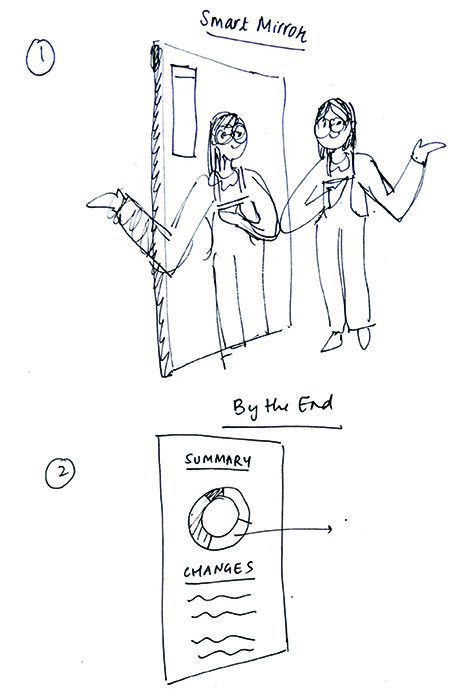To better understand machine learning, we split into groups and played a card game of sorts.
In groups, choose three prompts. For each prompt, choose three cards. Discuss amongst one another different ways the prompt can be addressed via the cards you chose. Pick the best of the 3 scenarios and rapid prototype (sketch) it out.
Example prompt: Improve your relationship with your spouse
Example card: Track/Analyze language, tone
“The machine could analyze text message, voicemails, and emails and look for patterns in language and tone. Positive and negative connotations could be drawn from the data, and could aid in your communication with your spouse.”
Our Scenario
Prompt: Improve your speech for the PTA meeting.
We envisioned a smart mirror of sorts, but instead of a mirror, an avatar would appear. Many people are uncomfortable speaking to themselves in the mirror, so the avatar would appease that fear and would also double as a test audience. The system would track/analyze the user’s heart rate and body temperature. Spikes in either data segment would imply a rise in stress and anxiety related to public speaking.
The avatar would also serve as a test audience. If the user began to drone on with facts and figures less relevant to the preferred audience (PTA), the avatar could nod off or look bored. It also allows the user to practice engagement.
At the end of each practice round, the user would be able to access and view a data summary. It would include body stats like heart rate, body temperature but also include qualitative feedback like content and engagement. The system would collect and analyze data about the audience and determine feedback from the findings. For instance, the avatar could suggest adding a sentence about sports programs because most parents on the PTA have students on the soccer team. It could also offer corrections like suggesting fewer hand gestures, pointing out fidgeting or grammatical errors. Over time, this system would adjust to each user and become more personalized. The system would learn of a user tends to pace too much, speaks too quietly, etc.
REFLECTIONS
Quick prototyping sessions always spook me because everything happens so fast, there’s so much pressure, and sometimes it can be difficult to rein in all the ideas on the table. But this exercise was a reminder for me to go with my gut, and trust others. We came up with a great idea that fit the brief but also holds a lot of potential for further ideations.

